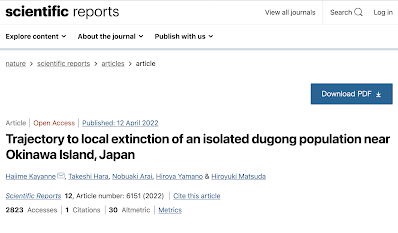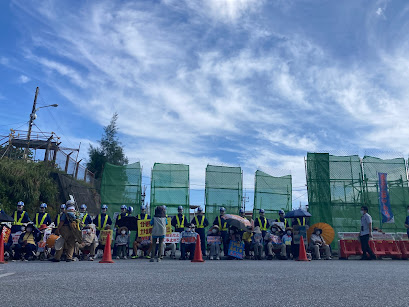Dugong Extinction Articles vs My Comments and Governor Tamaki's Disapproval of Seafloor Reinforcement Work
My comments on the article "Trajectory to local extinction of an isolated dugong population near Okinawa Island" can now be read in the comment section below the article on the Scientific Reports website. I am glad and thankful that Scientific Reports reviewed and decided to upload my comments on its website. (I posted a pdf version of my comments below.)
The article is the revised version of the original article "Local extinction of an isolated dugong population near Okinawa Island" by the same authors. I submitted comments on the original article as well. Three of the five authors of the article are members of the Environmental Monitoring Committee set up by the Ministry of Defense for the base construction project at Henoko-Oura Bay. The main argument of their articles is that the Okinawa dugong is extinct. However, the revised version uses a more careful expression "the Okinawa dugong is near-extinct or extinct."
The extinction articles and Governor Tamaki's disapproval of seafloor enforcement work
I hope the publication of my comments proves to be timely and beneficial to Governor Denny Tamaki/Okinawa prefectural government in light of their ongoing administrative and judicial battles against the Japanese government, especially over Governor Tamaki's major decision: In November 2021, Governor Tamaki disapproved of the Japanese government's application for changes in construction design and work (seafloor reinforcement work) for the Henoko base construction project. His disapproval presents a significant obstacle to the Henoko base project.
Governor Tamaki's disapproval is based upon three main arguments. First, given the presence of mayonnaise-like soft seafloor on the construction site, the feasibility of the construction project is in question. Second, the mega-scale seafloor reinforcement work needed for the project would adversely impact dugongs, an endangered species, and Japan's Natural Monument. Third, thus, this project can not be considered as a replacement facility for Futenma Air Station.
In contrast, the Japanese government has insisted that seafloor enforcement work is feasible and that there will be no impact from enforcement work on the dugong. The revised article (and the original article) would fit well with the government's second argument: If Okinawa dugongs are extinct, there will be no way seafloor reinforcement work would impact them.
Without any counter arguments to the revised article articulated in an internationally recognized venue, the publication of the revised article in Scientific Reports would have given full legitimacy to the narrative of the extinction of the Okinawa dugong, thus to the Japanese government's push for seafloor reinforcement work. Hopefully, the publication of my comments in the same journal could provide some checking on the extinction narrative. And to that end, I will write a more comprehensive politico-environmental article for an international journal, covering the issues of the Governor's disapproval, soft seafloor, and dugongs (and the dugong extinction articles).
For now, I will present two arguments I want people to realize through the publication of my comments in Scientific Reports.
 |
| Governor Tamaki Press Conference (Nov. 25, 2021) regarding his disapproval of seafloor reinforcement work Image Source: East Asia Community Institute Ryukyu-Okinawa Center |
First, I hope people can realize, despite the scientific contribution it makes, the revised article is peculiar.
Its peculiarity is apparent in the authors' adherence to the notion that the Okinawa dugong is extinct. In fact, their original article declared the extinction of the Okinawa dugong, and we thwarted that blunt declaration. The revised version incorporated the same idea but used this careful yet awkward description "In any case, it is difficult to maintain the population with the remaining two dugongs, so we have to say that the Okinawa dugong is near-extinct or extinct." Why were the authors not contented with the notion of "near extinction"? Why did they have to go through all troubles to say Okinawa dugongs are extinct in an international journal? Or, put another way, who benefits from the extinction of the Okinawa dugong? (Probably Japanese Defense Ministry?)
The peculiarity of the article is however most apparent in that the authors were not transparent about their involvement in the Henoko base construction project. They declared that there were no competing interests in writing this article, and this obviously raises ethical questions. Why could they have been honest about their involvement as many other authors do in similar circumstances? Well, if they had declared their involvement with the construction project, that would have opened Pandora's box in an international journal. Again, why did they have to go through all troubles, including risking ethical questions, to say Okinawa dugongs are extinct in an international journal? Again, put another way, who benefits from the extinction of the Okinawa dugong? (Probably again Japanese Defense Ministry?)
Trajectory of international efforts to save the Okinawa dugong (from the articles)
Through the publication of my comments, I hope people can see how a small group of people can put a competent challenge to those in power in an international forum when you have support from experts, international institutions, determined reporters, and colleagues/friends.
While I alone am fully responsible for my comments, my comments are products of my interactions with others who care about the Okinawa Dugong and see these articles as problematic.
It was one of my NGO colleagues in the U.S. who, in early May 2021, directed my attention to the original article. I took upon the challenge and I wrote and submitted comments on it to Research Square. Meanwhile, on Kyodo News published a piece on the article, and the Kyodo piece circulated in many newspapers in Japan. The Sirenian Specialist Group (SSG) of the International Union for Conservation of Nature also questioned the original article. The SSG sent the Okinawa Prefectural Government a letter stating that "[article's] claim that the dugong is extinct in Okinawa has no status even if the paper is published. In December 2019, IUCN listed the Nansei population of the dugong as Critically Endangered on the basis of the following listing assessment." In July 2021, the authors were asked to make major revision to the article.
Then, in April 2022, a close friend/colleague of mine in the field of forest conservation notified me of the publication of the revised article in Scientific Reports. I immediately wrote and sent comments to the editor of Scientific Reports/Nature.
And then in January 2023, one of my colleagues in the U.S., this time in the field of Asian studies, directed me to a report on the extinction of dugongs in Chinese waters: this report cited the revised article and had a sentence mentioning dugongs in Okinawa were extinct. Surprised, I contacted the author and editor of the Chinese dugong report. I informed them that the Okinawa dugong is not extinct and that the revised article the author cited was misleading. I suggested to them other references, including the IUCN assessment of the status of the dugongs in the Nansei region. The author of the report revised the misinformed sentence, and now it reads "the Japanese [dugong ] population appears to be worryingly small."
This last exchange with the reporter and editor led me to re-submit my comments with slight revisions to Scientific Reports. And you can read them on the Scientific Reports website.
The authors of the dugong extinction articles can write about the "trajectory to local extinction of a dugong population near Okinawa Island" in any way they want. We respect their pursuit of scientific inquiry. But they need to realize that there are many others, local citizens, experts, media reporters, and international institutions, who have been engaging in and writing about the trajectory of international efforts to save the Okinawa dugong.
Hideki Yoshikawa
Director
Okinawa Environmental Justice Project




